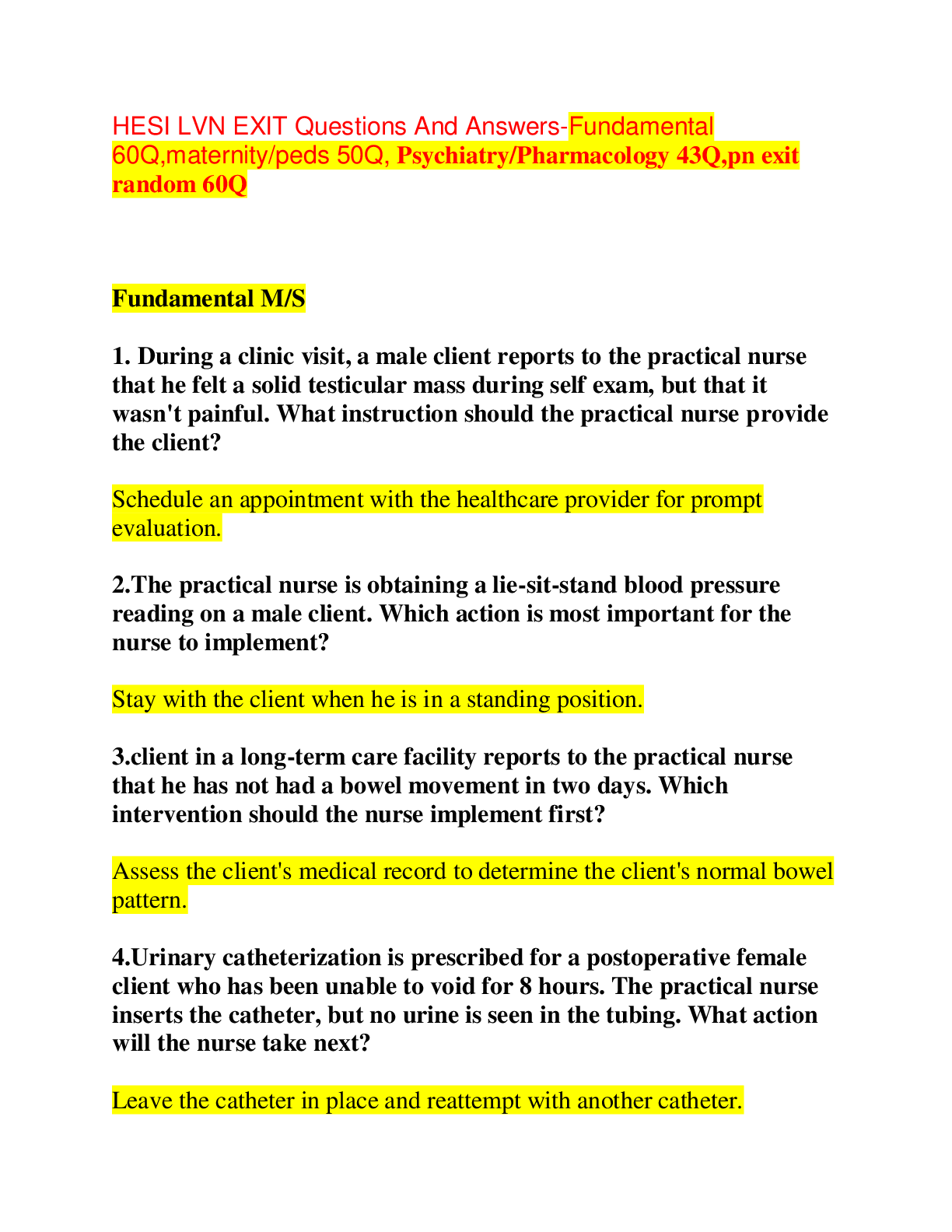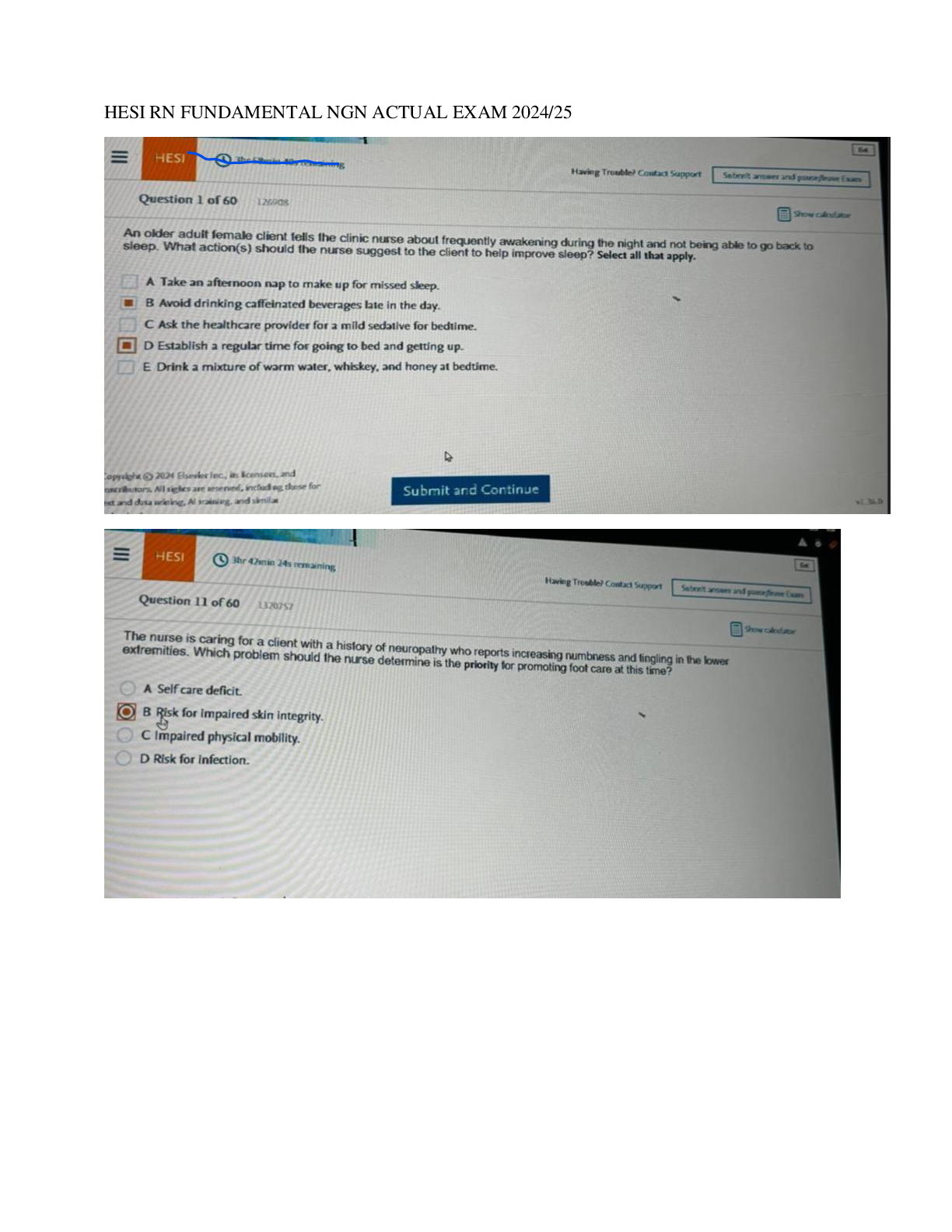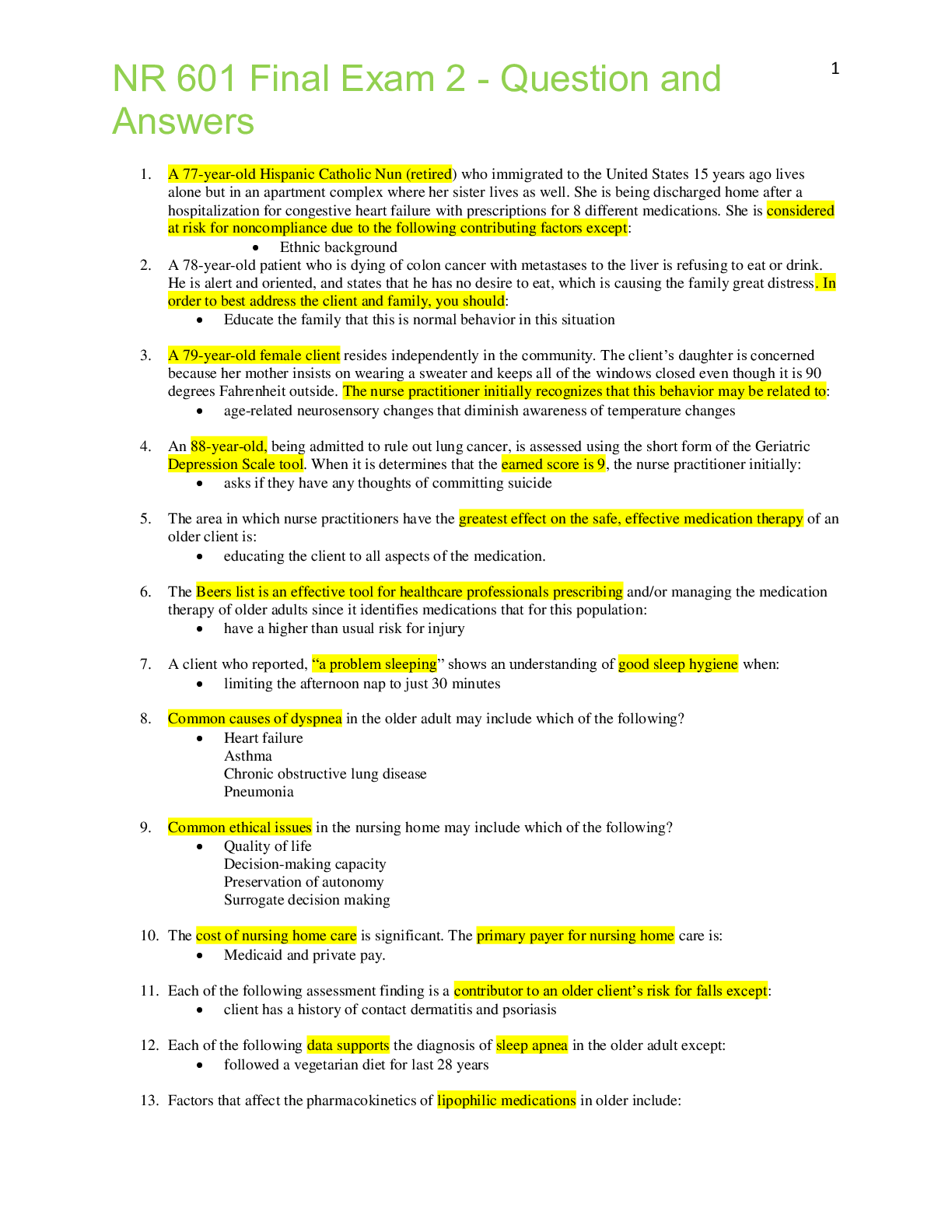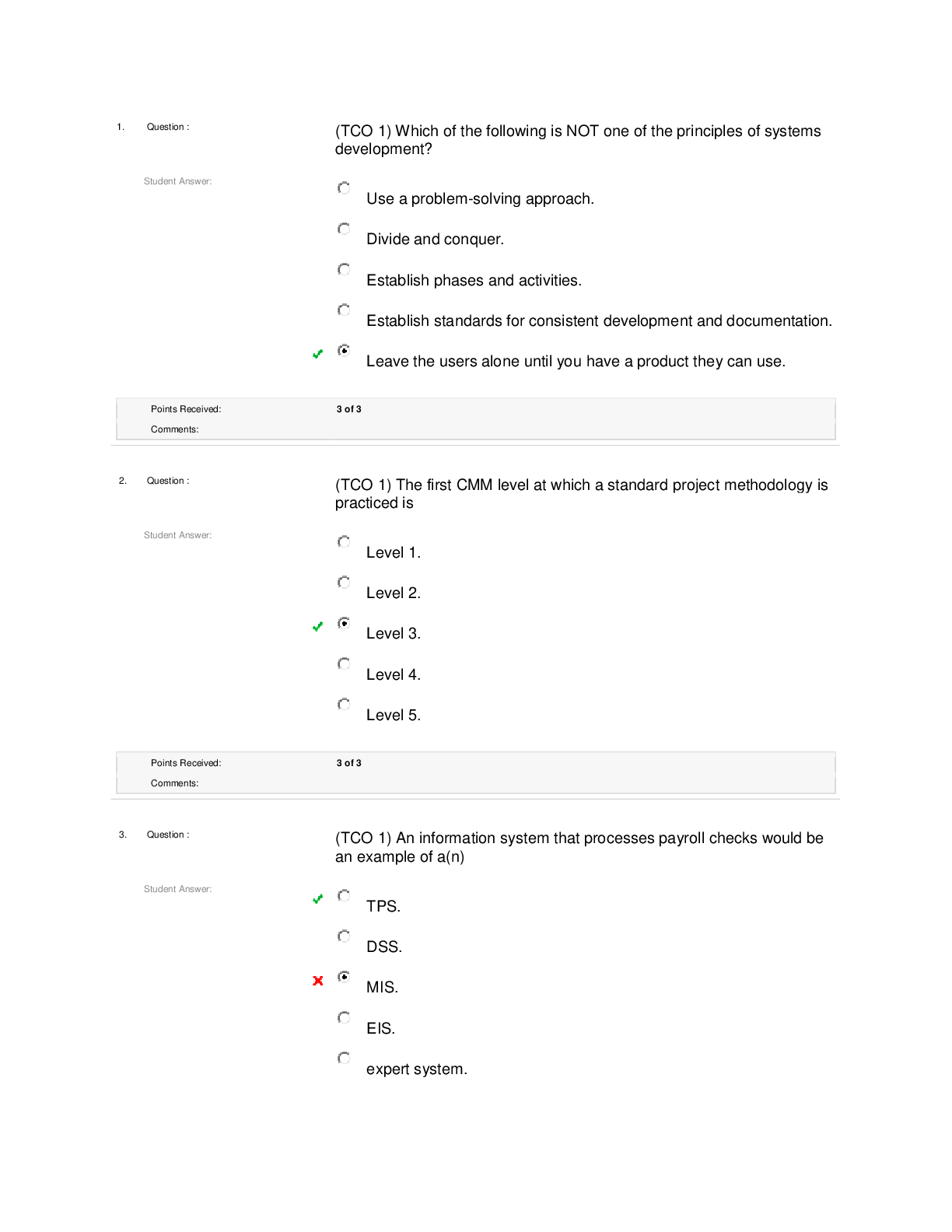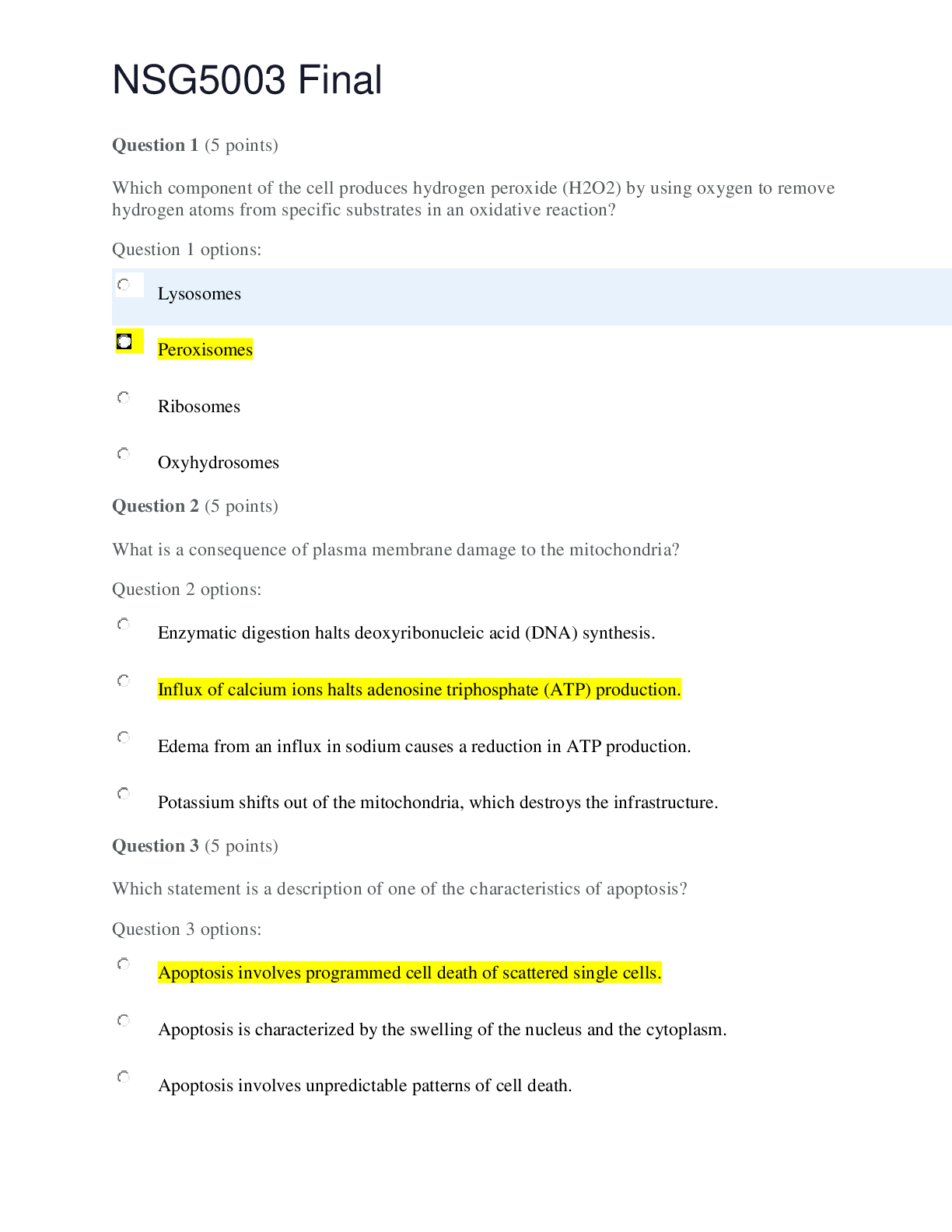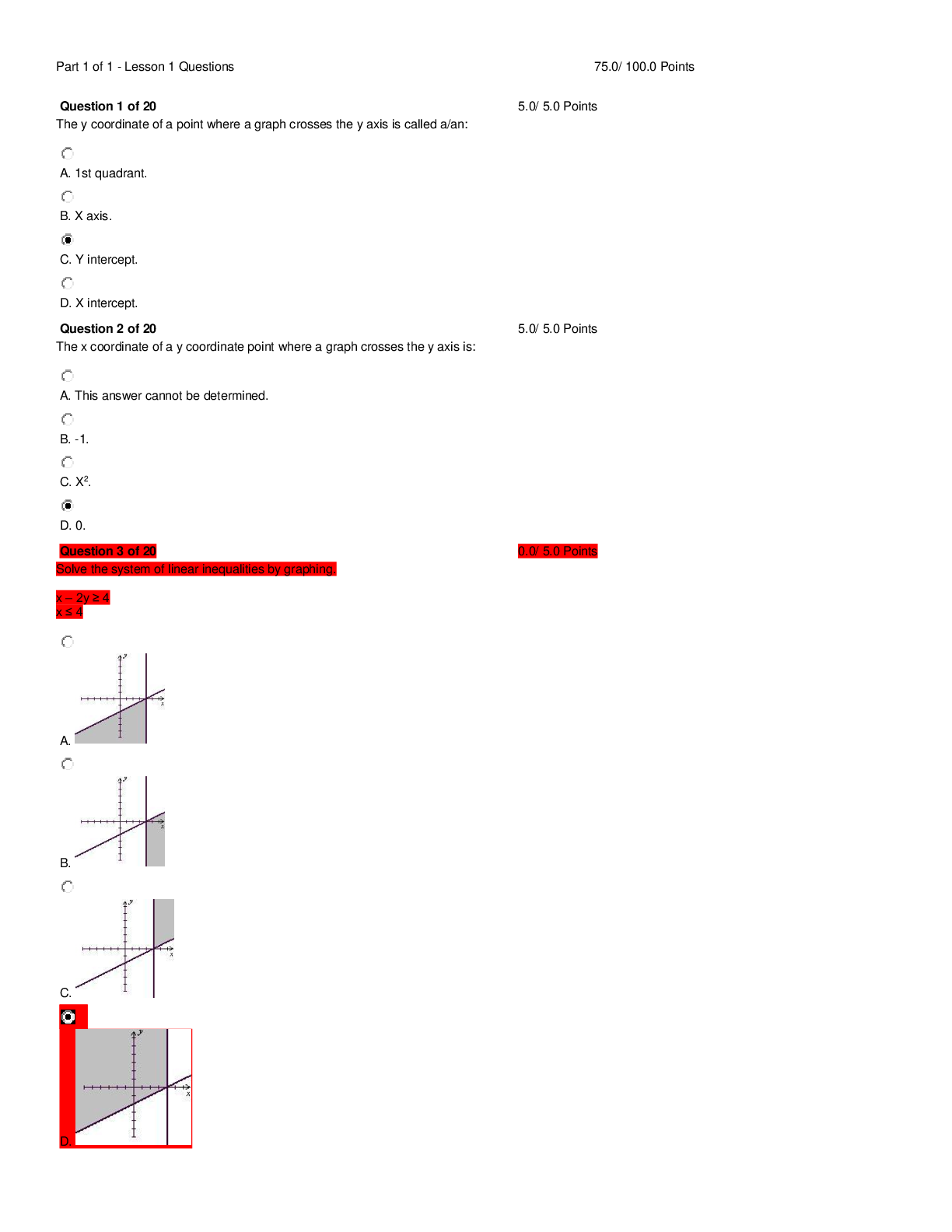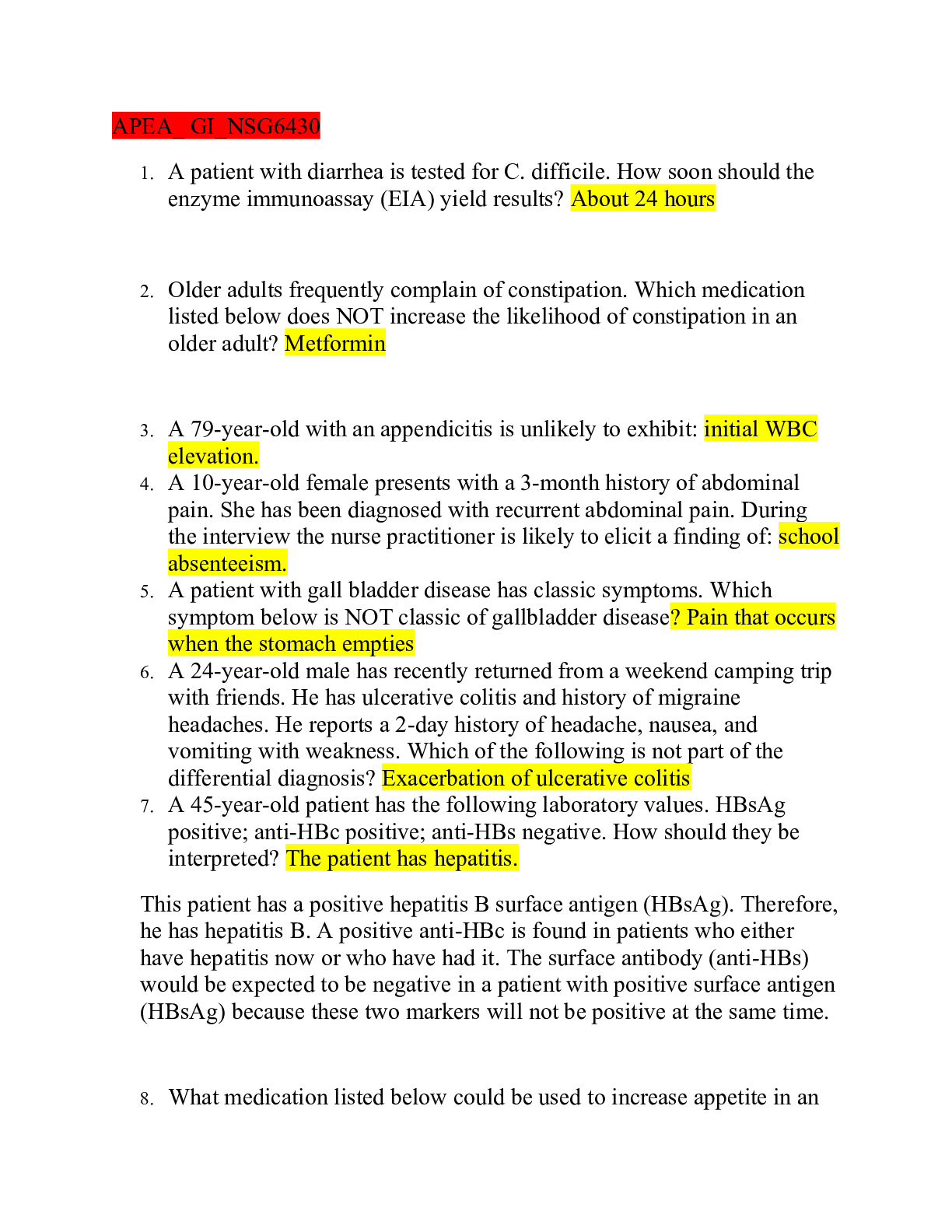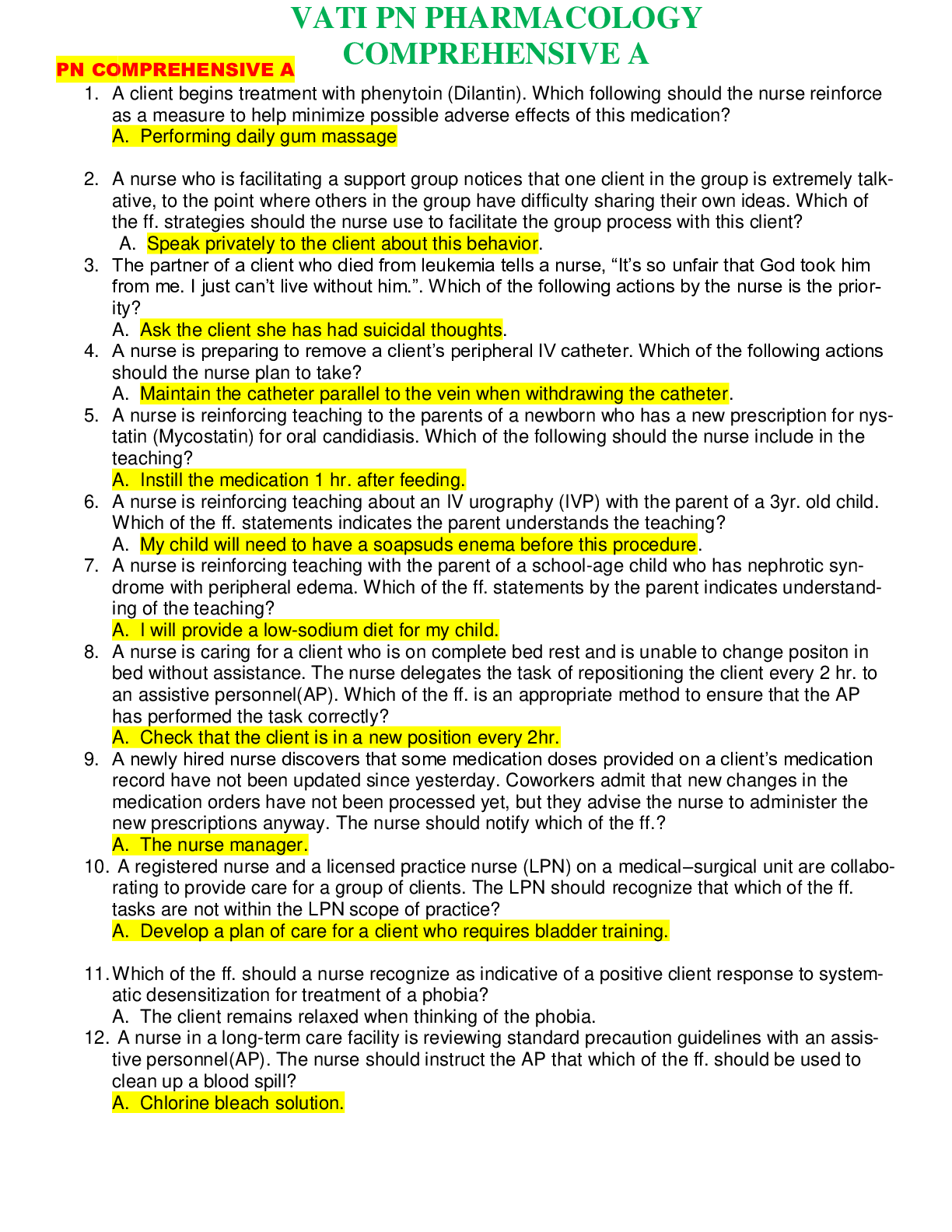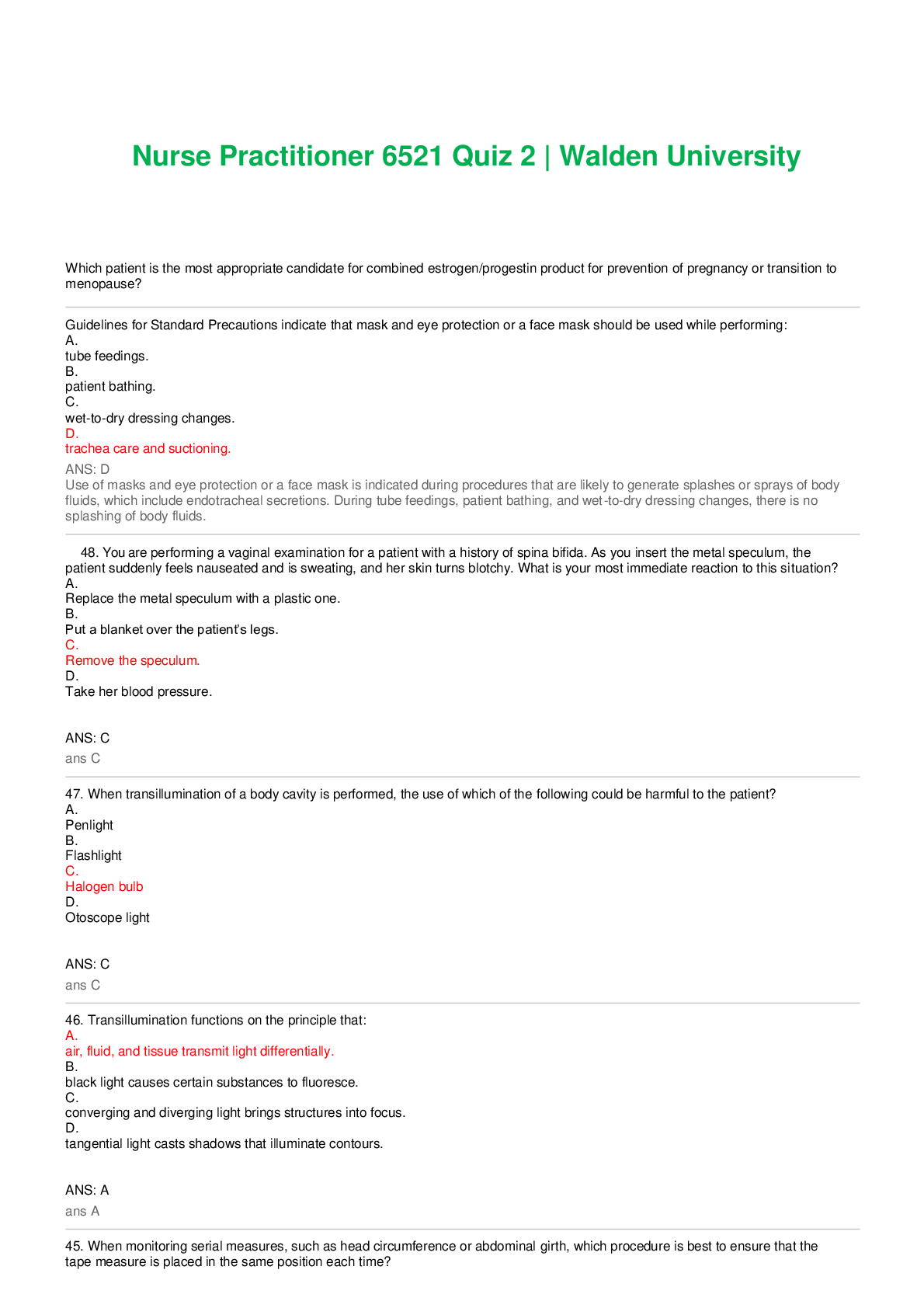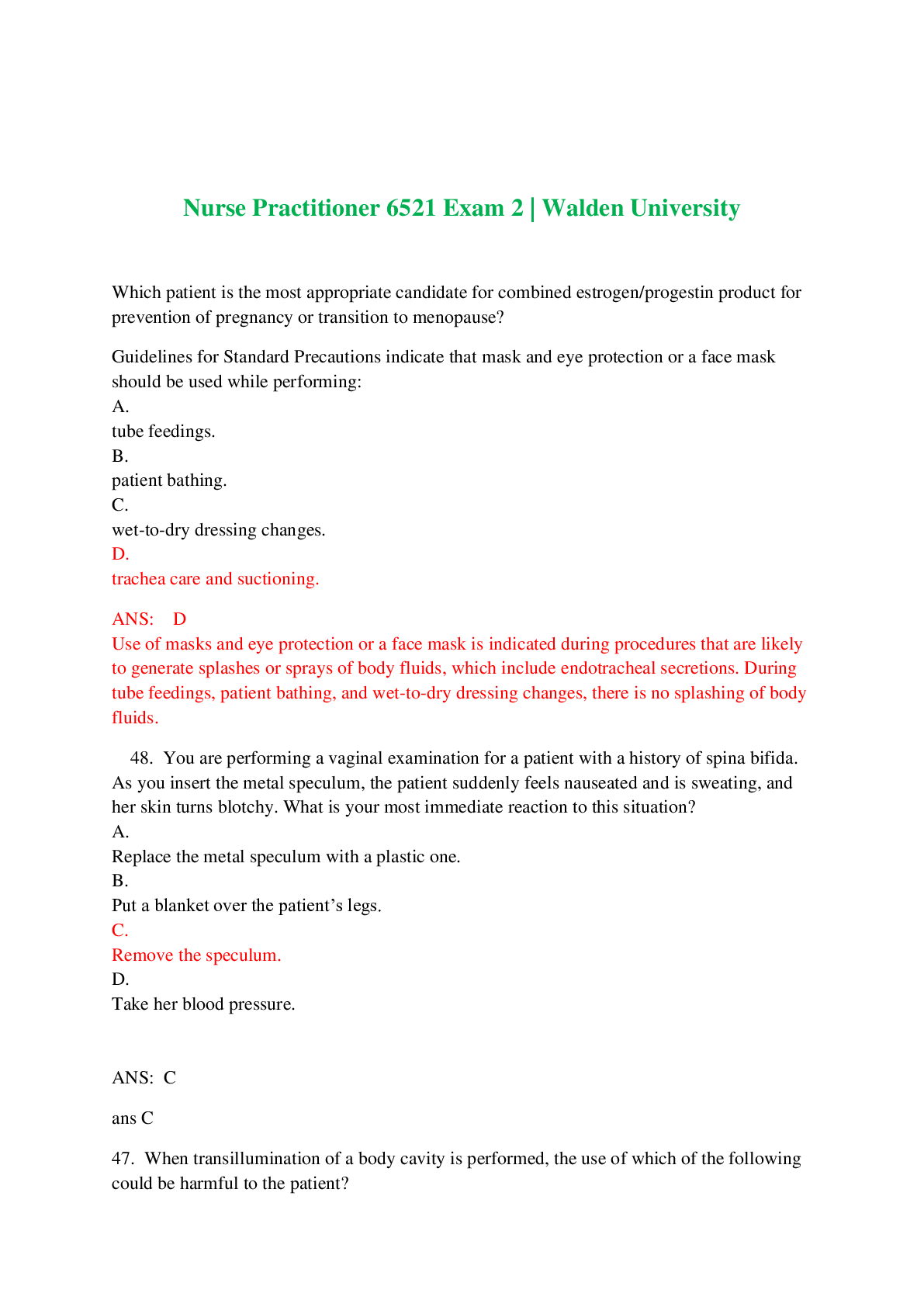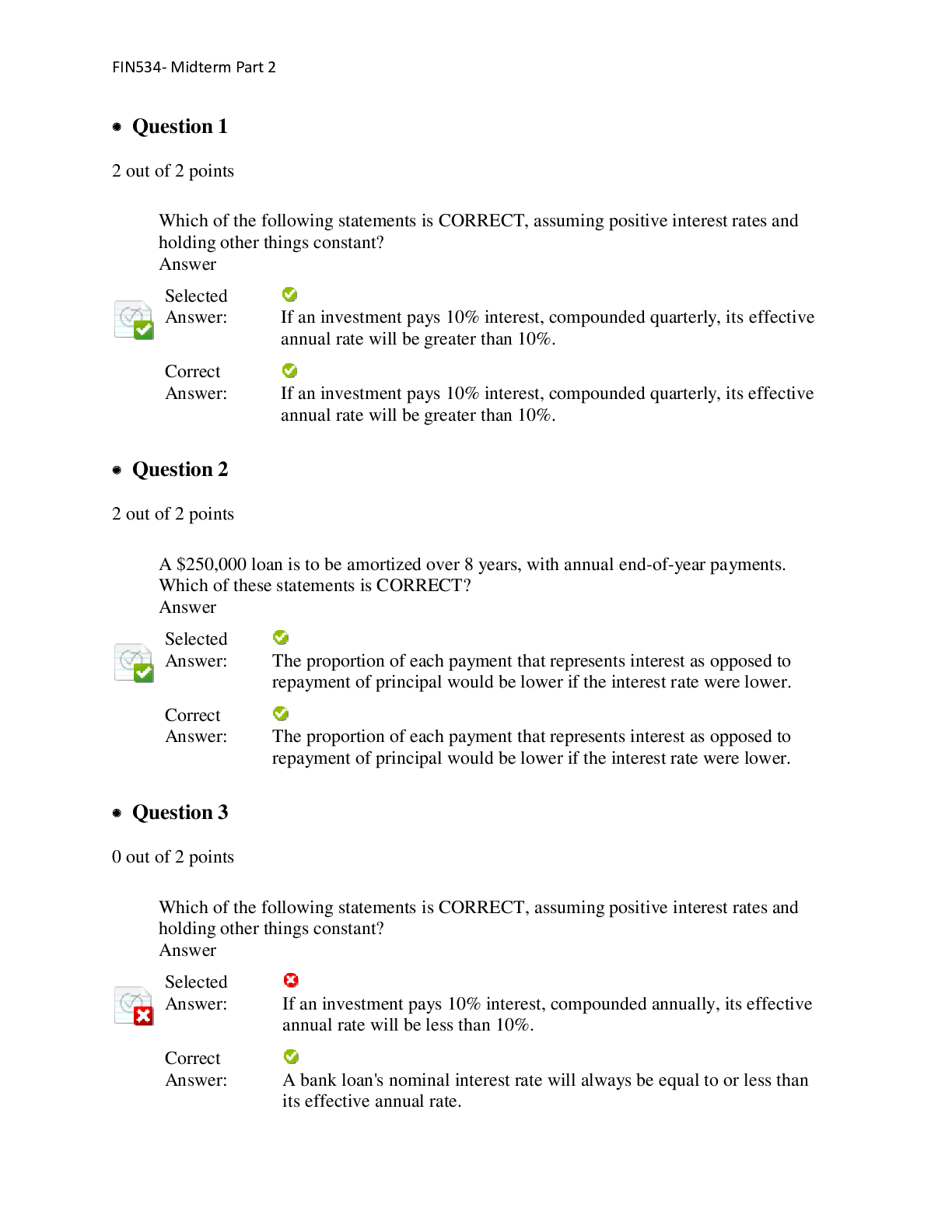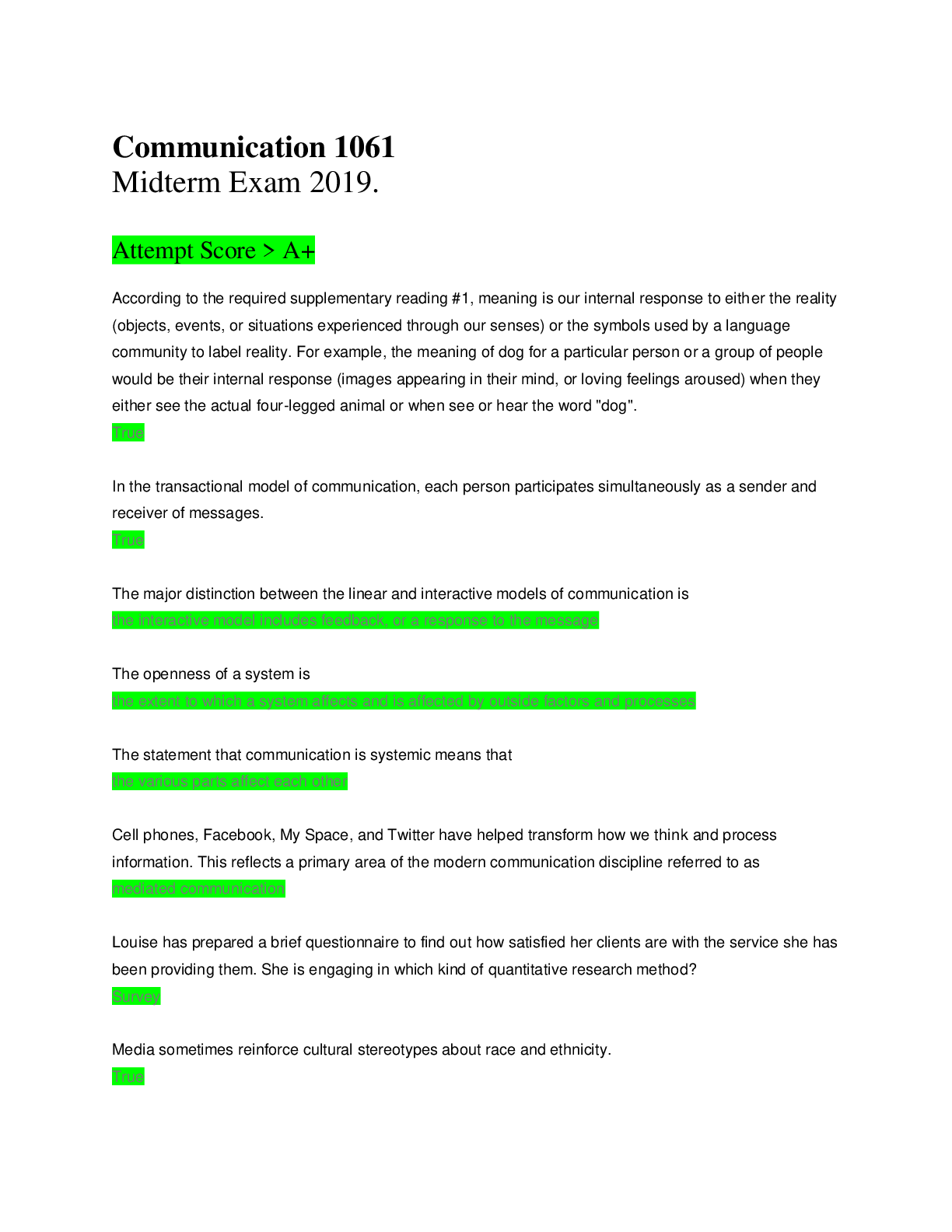*NURSING > EXAM > NURS 6640 Psychotherapy With Individuals | NURS 6640 PMHNP Week 6 Midterm Exam 2 | Walden University (All)
NURS 6640 Psychotherapy With Individuals | NURS 6640 PMHNP Week 6 Midterm Exam 2 | Walden University
Document Content and Description Below
NURS 6640 Week 6 Midterm Exam_NURS 6640 Psychotherapy With Individuals. Walden University-PMHNP A PMHNP is treating a 45-year-old female patient who is upset that her brother has not been calling sin... ce his divorce. When asked to describe her brother and what prompts him not to call as frequently, she says, “Everything is about him, not me. I think he’s jealous that I have a good marriage and he wants me to be unhappy, too. So he doesn’t call to upset me and ruin my relationships.” Based on this information, the PMHNP can conclude that the patient _________. When a PMHNP is seeing a patient for the first time, what is an important step to assure that the patient and provider understand the limits of their discussion? ou are seeing a 29-year-old widow whose husband recently died overseas while serving his country in the military. She has been mourning the loss of her husband for several months, and continues to grieve. She refuses to go to group grieving sessions, but reports that she is still able to go to work and her fitness classes sometimes, and even makes attempts to stay social. She says, “Sometimes it’s like he’s not even gone. Other times it feels like it’s been an eternity since I’ve seen him. It’s hard to talk about this type of stuff with my girlfriends, especially since all of their husbands are still alive.” The PMHNP understands that it is appropriate to employ which therapeutic principle? The PMHNP is treating a 35-year-old male officer in the military. He discloses that both of his parents are deceased and that he loved them. However, he says that he had feelings of inadequacy because his parents held him to a standard that he could never achieve. He went on to say that nothing he did ever felt good enough. The PMHNP assesses that this patient has perfect creases in his uniform with no strings or tags out of place; she also notices that he has perfect posture and questions him about ritualistic behaviors. She suspects that this patient has maladaptive responses to the expectations placed on him as a teenager and young adult. Which statements made by the patient would verify the PMHNP’s suspicion? The PMHNP is working with a patient who experiences anxiety around her parents that later leads to poor impulse control. What will the PMHNP do to employ psychodynamic psychotherapy properly for this patient? The PMHNP has been treating a 15-year-old patient with a history of abuse and neglect. Thirty minutes into their therapy session the patient jumps up and begins to pace around the room. Utilizing Socratic dialogue (SD) the PMHNP’s best action would be to: During cognitive behavioral therapy (CBT), a 64-year-old male patient states, “I get so frustrated sometimes and I just blow up at everybody!” Which response by the PMHNP demonstrates translation of Socratic dialogue (SD)? The PMHNP understands that anxiety and depression are two disorders in which their symptoms may overlap. When discussing this, you explain that the autonomic nervous system is activated and further helps distinguish anxiety symptoms by making the following points: The PMHNP meets with an adolescent patient who has depression and often presents with resistance when discussing his parent’s divorce. For the past couple of sessions, the patient has been quiet, sometimes refusing to speak. To further support the therapeutic relationship, the PMNHP: The PMHNP is working with a patient who experiences abreactions when discussing repressed feelings of his sexual abuse as a child. What can the PMHNP do to manage the patient’s intense emotional reactions? A 35-year-old patient seeks treatment for depression and anxiety after an abusive relationship. To help empower the patient, the PMHNP wants to teach the safe-place exercise to create a feeling of calm. In order to walk the patient through the exercise, the PMHNP first says: True or false: A PMHNP may ask his patient to describe her relationship with her father, both as a child and now, in order to assess interpersonal style. An initial evaluation reveals that an 11-year-old patient has moved to a new school after her parents’ recent divorce, and is having trouble making friends. The patient has normal mental status and exhibits appropriate behavior. What is the most appropriate scale for the PMHNP to use to get more information? A 62-year-old patient has been diagnosed with borderline personality disorder. Upon assessment, the PMHNP learns that he participates in spending sprees and occasional binge eating, accompanied by rapid changes in self-image. Which evidence-based psychotherapeutic model does the PMHNP identify as effective and beneficial? The PMHNP is working with an adult patient who has somatic complaints caused by a history of childhood abuse. As part of the therapeutic process, what does the PMHNP do to assess and organize a trauma history? The PMHNP is working with a veteran who has posttraumatic stress disorder (PTSD). The PMHNP believes that dual awareness will be beneficial in allowing the patient to focus on the here and now. What strategies can the PMHNP use to develop dual awareness in the patient? A PMHNP is treating a 50-year-old patient who suffers from depression. When he was growing up, he was often responsible for taking care of his three younger siblings. Since then, the patient puts other people’s needs before his own. Based on this information, the PMHNP would conclude that his interpersonal style is __________.The PMHNP is working with a patient who is living in poverty and abusing substances. According to the treatment hierarchy framework, what needs does the PMHNP need to attend to first? During a session, the PMHNP asks a patient with a history of sexual abuse to recall the relationship she had as a child with her parents. The patient responds by saying she has a headache and her stomach hurts, and starts talking about her physical ailments. What is the appropriate response by the PMHNP? The PMHNP is mentoring a student. After working with a patient during a session, the student laments about all the things she should have, or could have, said to the patient. “I feel guilty that I didn’t speak up more about the patient’s concern toward her son,” says the student. The PMHNP understands that the student is exhibiting signs of which therapeutic concept? The PMHNP is working with a patient who witnessed her father pass away after suffering for several months from terminal cancer. The PMHNP sees this as a traumatic event. The patient reports sometimes feeling out of touch with surroundings; almost as if things feel like a dream. “Sometimes that sensation lingers for a while,” the patient says, “and other times I snap out of it quickly.” What does the PMHNP infer about the condition based on psychotherapy concepts for trauma? A 65-year-old patient has suffered the loss of his wife. He is in a state of hyperarousal with increased sympathetic nervous system arousal. One or more interventions may help the patient to deal with this arousal. To decrease sympathetic nervous system arousal, the PMHNP’s treatment strategy is ___________. The PMHNP has been assisting a shy and timid 23-year-old male patient struggling with esteem and self-concept issues. Over the weekend, this patient was given the task of completing an exercise that would usually cause him distress and shame, also called a shame-attacking exercise. The PMHNP determines that this task has successfully been achieved when the patient states: A 16-year-old female patient has had a stable therapeutic relationship with the PMHNP for several months. The PMHNP notices what appears to be fresh cigarette burns on the patient’s arm. When asked, the patient admits to this self-injurious behavior. Although the patient is still depressed, her mood seems to be somewhat better this week. True or false: The PMHNP would most likely consider this patient stabilized and ready to move to Stage II. The PMHNP is meeting with a 42-year-old man with depression brought on by the recent passing of his wife. As he describes the circumstances surrounding his late wife’s death, the PMHNP begins to feel sad. The sadness lingers for several hours, and the PMHNP finds it difficult to focus on other patients for the rest of the day. What is the most appropriate explanation for the reaction that the PMHNP is experiencing? A PMHNP is preparing confidentiality forms for his patients. What is the most appropriate first step he should take? The PMHNP employs psychodynamic psychotherapy with a patient who experiences anxiety and depression. As the process enters the psychoanalytic end of the psychodynamic continuum, the PMNHP will focus on: During a therapy session the patient is asked how she currently deals with stress, and she says, “Well, I don’t. I just let it build and build.” The PMHNP responds by asking how well this has been working out for her. The patient states, “Well, to be honest, it just feels like I’m drowning, you know what I mean.” Illustrating idiosyncratic meaning, the PMHNP responds with: A 35-year-old patient has been seeking treatment for depression for several months. The PMHNP does an assessment to see if processing has led to adaptive change. The patient’s self-references are positive in relation to past events, work is productive, relationships are adaptive, and there is congruence between behavior, thoughts, and affect. Based on this information, the PMHNP decides the patient ____________. During cognitive behavioral therapy (CBT), a 64-year-old male patient, states, “My wife hates me! She’s just waiting for me to die.” Using Socratic dialogue (SD) the PMHNP demonstrates understanding of analysis when she responds: When the patient comes into the office, she says, “I just saw a friend of mine out in the waiting room. What’s wrong with him?” The PMHNP says, “He’ll be fine. He has mild depression.” Which of the following statement is correct related to confidentiality rights? The PMHNP is treating a patient with a substantial fear of feeling closed in (claustrophobia). Thus, the patient will not get into an elevator. The office where he works is on the 10th floor and this requires that he walk up and down the stairs in the morning and evening to get to his office. With permission from the patient, the PMHNP is beginning systematic desensitization to address the patient’s need to use the elevator. What is the PMHNP’s best plan of action? A PMHNP has been working with a young female patient who suffers from depression to change self-defeating behaviors. By creating a presence of acceptance and using good listening skills, the PMHNP’s overall goal is to __________. A 41-year-old male patient is meeting with the PMHNP and reveals that he is homosexual. He begins telling the PMHNP about his feelings as a homosexual, middle-aged man. The PMHNP nods understandingly. Before long, the patient asks, “Are you gay? Are you married? Do you have kids?” What is the best response by the PMHNP? The patient is a 56-year-old female patient diagnosed with panic disorder and reports symptoms that include heart palpitations, frequent trembling, and feelings of choking in stressful situations. What special consideration does the PMHNP make? [Show More]
Last updated: 8 months ago
Preview 4 out of 17 pages

Loading document previews ...
Buy this document to get the full access instantly
Instant Download Access after purchase
Buy NowInstant download
We Accept:

Reviews( 1 )

by fadeke · 5 years ago
$10.00
Can't find what you want? Try our AI powered Search
Document information
Connected school, study & course
About the document
Uploaded On
Jan 05, 2020
Number of pages
17
Written in
Additional information
This document has been written for:
Uploaded
Jan 05, 2020
Downloads
1
Views
304

